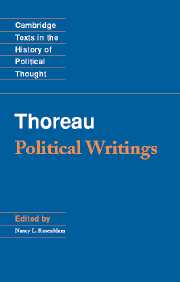Book contents
- Frontmatter
- Contents
- Acknowledgements
- Introduction
- Chronology
- Bibliographical note
- Resistance to Civil Government (Civil Disobedience)
- Selections from Walden
- Life without Principle
- Slavery in Massachusetts
- A Plea for Captain John Brown
- Martyrdom of John Brown
- The Last Days of John Brown
- Index
- Cambridge Texts in the History of Political Thought
Introduction
Published online by Cambridge University Press: 05 June 2012
- Frontmatter
- Contents
- Acknowledgements
- Introduction
- Chronology
- Bibliographical note
- Resistance to Civil Government (Civil Disobedience)
- Selections from Walden
- Life without Principle
- Slavery in Massachusetts
- A Plea for Captain John Brown
- Martyrdom of John Brown
- The Last Days of John Brown
- Index
- Cambridge Texts in the History of Political Thought
Summary
Thoreau's life
Thoreau's life and work focus uncompromisingly on the question, how should I live? His titles prepare the way: “Where I Lived and What I Lived For,” “Life Without Principle,” and Walden, or Life in the Woods, whose opening chapter, “Economy,” is an extended reflection on “the true necessaries and means of life” (p. 27). Thoreau's questioning is unwavering and exhaustive, personal and individual. No element of day-to-day life can be left unexamined if “our whole life is startlingly moral” (p. 87). The troubling political questions that face men and women – such as an individual's responsibility for social injustice, the obligation to obey political authority, and reasons for civil disobedience – arise as part of a whole life, in which we have other affairs to attend to. Thoreau asks not only about the best form of government but how much a person should have to do with government at all? If Thoreau is not a political philosopher like others in this Cambridge Texts series, it is less because his style of thought is unsystematic or his references to the history of political thought are few, and more because of his insistence that political society's claim on us is conditional and intermittent, and that government's contribution to a well-spent life is only comparatively important. Thoreau has “several lives to live” besides that of democratic citizen.
- Type
- Chapter
- Information
- Thoreau: Political Writings , pp. vii - xxxiPublisher: Cambridge University PressPrint publication year: 1996



